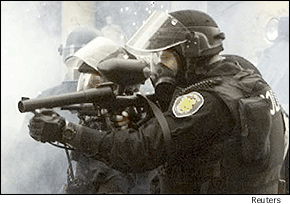
The Battle Engaged
by Paul de Armond
 |
by Paul de Armond |
|
 Shortly
after 10AM, the Seattle Police Department got their show on the road and began using tear gas to clear the streets.
Shortly
after 10AM, the Seattle Police Department got their show on the road and began using tear gas to clear the streets.
It's still not clear if the order was issued by Assistant Chief Ed Joiner -- Chief Stamper had delegated control of WTO to him and did not arrive at the commanders' meeting until late that afternoon -- or if was a spontaneous decision made by officers in the street. Fragmentary transcripts of recently released tapes of police radio traffic have so far not cast any light on this critical question. The use of gas may have been an effort to open a pathway into the protest area from outside, as the gas was fired at on Sixth Avenue, between University and Union Streets. This is the extreme southern end of the triangular area blockaded by the Direct Action Network. The Seattle Times said "police used gas to disperse demonstrators massing." Police officials later explained that the gas was an attempt to expand and re-connect their now isolated perimeters inside the crowds. None of these explanations makes much sense. The events surrounding the decision to use gas continue to be cloaked in confusion and controversy. Later claims that the police resorted to gas in response to widespread violent attacks and vandalism are now known to be absolutely untrue. The counter-claims that police were unprovoked and that the crowds were non-confrontive are equally untrue. The more aggressive demonstrators had moved towards the police positions and videotapes clearly show that there was no buffer space between the opposing sides in many areas. One segment aired on KIRO TV shows members of the Black Bloc confronting police and being extremely provocative, but not attacking anyone or committing vandalism. The police view of the crowd was framed by these more aggressive demonstrators, while the vast majority of the crowd was unable to see the police and was in a giddy, triumphant mood. It will require the investigations by the Seattle City Council, the ACLU, Amnesty International and other groups to determine if the use of gas was ordered by the police command or if it was a decision made in the streets. After the first canisters were fired, the use of tear gas and pepper spray spread rapidly throughout the protest area.
|
|
With
the release of the gas, mood in the streets rapidly changed. The police were successful in advancing against the crowd. There were no instances where police charges were repulsed, or where the crowds counter-attacked and cut off police. One major effort to re-open the street connecting the Paramount Theatre to the hotels moved the crowds back until running out of steam. In short, the police tactics were of limited success and ineffective.
The net effect of the use of gas and the police charges was to cause the crowds to surge from one point to another without allowing police to gain control of the streets. In the midst of the melee, the "lock-down" affinity groups remained in place, blocking intersections and anchoring the protest to the area around the convention center. Police gassed and pepper-sprayed the immobile groups, but could not arrest them and remove them from the area due to the continued blockade. These tactics were both ineffective in getting the blockaders to move and successful in infuriating the crowds who saw their main mission as the protection of these groups. The crowds were now frightened and angry, but determined to maintain control of the streets. The overall strategic situation remained unchanged, despite the tactical chaos. The protesters numbers were sufficient to keep the blockade intact, though it was now a blockade of continuous movement. The police remained isolated inside the protest area without an open avenue to the outside through which arrestees could be removed. Both sides remained under the overall command of their respective strategies, regardless of the excitement. The area involved in the disorder -- and that's what it clearly was after an hour of tear gas and chaos -- spread down Pike and Pine Streets. The protests remained centered on the Convention Center and although the crowds expanded into the surrounding blocks under the police attacks, they kept surging back towards the conference site and the "lock-down" affinity groups holding the key intersections.
|
|
The
cohesion of the Direct Action Network was partly due to their improvised communications network assembled out of cell phones, radios, police scanners and portable computers. Protesters in the street with wireless Palm Pilots were able to link into continuously updated web pages giving reports from the streets. Police scanners monitored transmissions and provided some warning of changing police tactics. Cell phones were widely used.
Kelly Quirke, Executive Director of the Rainforest Action Network, reports that early Tuesday, "the authorities had successfully squashed DAN's communications system." The solution to the infrastructure attack was quickly resolved by purchasing new Nextel cell phones. According to Han Shan, the Ruckus Society's WTO action coordinator, his organization and other protest groups that formed the Direct Action Network used the Nextel system to create a cellular grid over the city. They broke into talk groups of eight people each. One of the eight overlapped with another talk group, helping to quickly communicate through the ranks. In addition to the organizers' all-points network, protest communications were leavened with individual protesters using cell phones, direct transmissions from roving independent media feeding directly onto the internet, personal computers with wireless modems broadcasting live video, and a variety of other networked communications. Floating above the tear gas was a pulsing infosphere of enormous bandwidth, reaching around the planet via the Internet.
Albion Monitor
February 29, 2000 (http://www.monitor.net/monitor) All Rights Reserved. Contact rights@monitor.net for permission to use in any format. | ||||||||